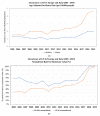Epidemiology of Legionnaires' Disease in Italy, 2004-2019: A Summary of Available Evidence
- PMID: 34835307
- PMCID: PMC8624895
- DOI: 10.3390/microorganisms9112180
Epidemiology of Legionnaires' Disease in Italy, 2004-2019: A Summary of Available Evidence
Abstract
Legionnaires' disease (LD) incidence has been increasing in several European countries since 2011. Currently, Italy is experiencing high notification rates for LD, whose cause still remains scarcely understood. We sought to summarize the available evidence on the epidemiology of LD in Italy (2004-2019), characterizing the risk of LD by region, sex, age group, and settings of the case (i.e., community, healthcare, or travel-associated cases). Environmental factors (e.g., average air temperatures and relative humidity) were also included in a Poisson regression model in order to assess their potential role on the annual incidence of new LD cases. National surveillance data included a total of 23,554 LD cases occurring between 2004 and 2019 (70.4% of them were of male gender, 94.1% were aged 40 years and older), with age-adjusted incidence rates increasing from 1.053 cases per 100,000 in 2004 to 4.559 per 100,000 in 2019. The majority of incident cases came from northern Italy (43.2% from northwestern Italy, 25.6% from northeastern Italy). Of these, 5.9% were healthcare-related, and 21.1% were travel-associated. A case-fatality ratio of 5.2% was calculated for the whole of the assessed timeframe, with a pooled estimate for mortality of 0.122 events per 100,000 population per year. Poisson regression analysis was associated with conflicting results, as any increase in average air temperature resulted in reduced risk for LD cases (Incidence Rate Ratio [IRR] 0.807, 95% Confidence Interval [95% CI] 0.744-0.874), while higher annual income in older individuals was associated with an increased IRR (1.238, 95% CI 1.134-1.351). The relative differences in incidence between Italian regions could not be explained by demographic factors (i.e., age and sex distribution of the population), and also a critical reappraisal of environmental factors failed to substantiate both the varying incidence across the country and the decennial trend we were able to identify.
Keywords: Legionella pneumophila typing; Legionnaires’ disease; cultivation; diagnosis; epidemiology.
Conflict of interest statement
The authors declare no conflict of interest.
Figures



References
-
- Löf E., Chereau F., Jureen P., Andersson S., Rizzardi K., Edquist P., Kühlmann-Berenzon S., Galanis I., Schönning C., Kais M., et al. An outbreak investigation of legionella non-pneumophila legionnaires’ disease in Sweden, April to August 2018: Gardening and use of commercial bagged soil associated with infections. Euro Surveill. 2021;26:1900702. doi: 10.2807/1560-7917.ES.2021.26.7.1900702. - DOI - PMC - PubMed
Publication types
LinkOut - more resources
Full Text Sources
Research Materials

